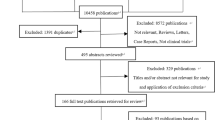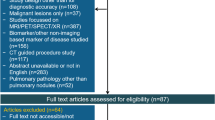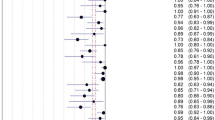Abstract
The purpose was to assess the clinical utility of diagnostic tests for identifying malignancy within a solitary pulmonary nodule (SPN), and to create a nomogram or “look-up” table using clinical data and non-invasive radiology (positive) test results to estimate post-test probability of malignancy. Studies that examined computed tomography (CT), magnetic resonance imaging (MRI), positron emission tomography (PET) and single photon emission computed tomography (SPECT) for the evaluation of SPN. Two reviewers independently abstracted data and assessed study quality. Study-specific and overall positive likelihood ratios (LRs) for each diagnostic test confirming a diagnosis of malignancy and negative LR for each diagnostic test excluding a diagnosis of malignancy within an SPN were calculated. Forty-four of 242 articles were included. Positive LRs for diagnostic tests were: CT 3.91 (95% confidence interval 2.42, 5.40), MRI 4.57 (3.03, 6.1), PET 5.44 (3.56, 7.32) and SPECT 5.16 (4.03, 6.30). Negative LRs were: CT 0.10 (0.03, 0.16), MRI 0.08 (0.03, 0.12), PET 0.06 (0.02, 0.09) and SPECT 0.06 (0.04, 0.08). Differences in performance for all tests were negligible; therefore, the clinician may confidently use any of the four tests presented in further evaluating an SPN. Given the low cost and prevalence of the technology, SPECT appears to be the leading choice for additional testing in SPN evaluation.






Similar content being viewed by others
References
Cronin P, Dwamena BA, Kelly AM, Carlos RC (2008) Solitary pulmonary nodules: meta-analytic comparison of cross-sectional imaging modalities for diagnosis of malignancy. Radiology 246(3):772–782
Swensen SJ, Silverstein MD, Ilstrup DM, Schleck CD, Edell ES (1997) The probability of malignancy in solitary pulmonary nodules: application to small radiologically indeterminate nodules. Arch Intern Me 157:849–855
Khan KS (2005) Systematic reviews of diagnostic tests: a guide to methods and application. Best Pract Res Clin Obstet Gynaecol 19:37–46
Deville WL, Buntinx F, Bouter LM et al (2002) Conducting systematic reviews of diagnostic studies: didactic guidelines. BMC Med Res Methodol 2:9
Cook DJ, Guyatt GH, Ryan G et al (1993) Should unpublished data be included in meta-analyses? Current convictions and controversies. JAMA 269:2749–2753
Higgins JP, Thompson SG, Deeks JJ, Altman DG (2003) Measuring Inconsistency in Meta-analyses. BMJ 327:557–560
Ferrucci JT et al (2004) Taveras and Ferrucci’s Radiology: Diagnosis, Imaging, Intervention, on CD-ROM, 2003 edn. Lippincott Williams & Wilkins, Philadelphia
Swensen SJ, Morin RL, Schueler BA et al (1992) Solitary pulmonary nodule: CT evaluation of enhancement with iodinated contrast material—a preliminary report. Radiology 182:343–347
Swensen SJ, Brown LR, Colby TV, Weaver AL (1995) Pulmonary nodules: CT evaluation of enhancement with iodinated contrast material. Radiology 194:393–398
Yamashita K, Matsunobe S, Tsuda T et al (1995) Solitary pulmonary nodule: preliminary study of evaluation with incremental dynamic CT. Radiology 194:399–405
Swensen SJ, Brown LR, Colby TV, Weaver AL, Midthun DE (1996) Lung nodule enhancement at CT: prospective findings. Radiology 201:447–455
Potente G, Iacari V, Caimi M (1997) The challenge of solitary pulmonary nodules: HRCT evaluation. Comput Med Imaging Graph 21:39–46
Zhang M, Kono M (1997) Solitary pulmonary nodules: evaluation of blood flow patterns with dynamic CT. Radiology 205:471–478
Swensen SJ, Viggiano RW, Midthun DE et al (2000) Lung nodule enhancement at CT: Multicenter study. Radiology 214:73–80
Yi CA, Lee KS, Kim EA et al (2004) Solitary pulmonary nodules: dynamic enhanced multi-detector row CT study and comparison with vascular endothelial growth factor and microvessel density. Radiology 233:191–199
Kim JH, Kim HJ, Lee KH et al (2004) Solitary pulmonary nodules: a comparative study evaluated with contrast-enhanced dynamic MR imaging and CT. J Comput Assist Tomogr 28:766–775
Jeong YJ, Lee KS, Jeong SY et al (2005) Solitary pulmonary nodule: characterization with combined wash-in and washout features at dynamic multi-detector row CT. Radiology 237:675–683
Hittmair K, Eckersberger F, Klepetko W, Helbich T, Herold CJ (1995) Evaluation of solitary pulmonary nodules with dynamic contrast—enhanced MR imaging-a promising technique. Magn Reson Imaging 13:923–933
Guckel C, Schnabel K, Deimling M, Steinbrich W (1996) Solitary pulmonary nodules: MR evaluation of enhancement patterns with contrast-enhanced dynamic snapshot gradient-echo imaging. Radiology 200:681–686
Ohno Y, Hatabu H, Takenaka D et al (2002) Solitary pulmonary nodules: potential role of dynamic MR imaging in management initial experience. Radiology 224:503–511
Kim JH, Kim HJ, Lee KH, Kim KH, Lee HL (2004) Solitary pulmonary nodules: a comparative study evaluated with contrast-enhanced dynamic MR imaging and CT. J Comput Assist Tomogr 28:766–775
Schaefer JF, Vollmar J, Schick F et al (2004) Solitary pulmonary nodules: dynamic contrast-enhanced MR imaging-perfusion differences in malignant and benign lesions. Radiology 232:544–553
Tozaki M, Ichiba N, Fukuda K (2005) Dynamic magnetic resonance imaging of solitary pulmonary nodules: utility of kinetic patterns in differential diagnosis. J Comput Assist Tomogr 29:13–19
Kubota K, Matsuzawa T, Fujiwara T et al (1990) Differential diagnosis of lung tumor with positron emission tomography: a prospective study. J Nucl Med 31:1927–1932
Gupta NC, Frank AR, Dewan NA et al (1992) Solitary pulmonary nodules: detection of malignancy with PET with 2-[F-18]-fluoro-2-deoxy-D-glucose. Radiology 184:441–444
Dewan NA, Gupta NC, Redepenning LS, Phalen JJ, Frick MP (1993) Diagnostic efficacy of PET-FDG imaging in solitary pulmonary nodules. Potential role in evaluation and management. Chest 104:997–1002
Patz EF Jr, Lowe VJ, Hoffman JM et al (1993) Focal pulmonary abnormalities: evaluation with F-18 fluorodeoxyglucose PET scanning. Radiology 188:487–490
Dewan NA, Reeb SD, Gupta NC, Gobar LS, Scott WJ (1995) PET-FDG imaging and transthoracic needle lung aspiration biopsy in evaluation of pulmonary lesions. A comparative risk-benefit analysis. Chest 108:441–446
Duhaylongsod FG, Lowe VJ, Patz EF Jr, Vaughn AL, Coleman RE, Wolfe WG (1995) Detection of primary and recurrent lung cancer by means of F-18 fluorodeoxyglucose positron emission tomography (FDG PET). J Thorac Cardiovasc Surg 110:130–139
Duhaylongsod FG, Lowe VJ, Patz EF Jr, Vaughn AL, Coleman RE, Wolfe WG (1995) Lung tumor growth correlates with glucose metabolism measured by fluoride-18 fluorodeoxyglucose positron emission tomography. Ann Thorac Surg 60:1348–1352
Gupta NC, Maloof J, Gunel E (1996) Probability of malignancy in solitary pulmonary nodules using fluorine-18-FDG and PET. J Nucl Med 37:943–948
Bury T, Dowlati A, Paulus P et al (1996) Evaluation of the solitary pulmonary nodule by positron emission tomography imaging. Eur Respir J 9:410–414
Dewan NA, Shehan CJ, Reeb SD, Gobar LS, Scott WJ, Ryschon K (1997) Likelihood of malignancy in a solitary pulmonary nodule: comparison of Bayesian analysis and results of FDG-PET scan. Chest 112:416–422
Hagberg RC, Segall GM, Stark P, Burdon TA, Pompili MF (1997) Characterization of pulmonary nodules and mediastinal staging of bronchogenic carcinoma with F-18 fluorodeoxyglucose positron emission tomography. Eur J Cardiothorac Surg 12:92–97
Gupta N, Gill H, Graeber G, Bishop H, Hurst J, Stephens T (1998) Dynamic positron emission tomography with F-18 fluorodeoxyglucose imaging in differentiation of benign from malignant lung/mediastinal lesions. Chest 114:1105–1111
Lowe VJ, Fletcher JW, Gobar L et al (1998) Prospective investigation of positron emission tomography in lung nodules. J Clin Oncol 16:1075–1084
Orino K, Kawamura M, Hatazawa J, Suzuki I, Sazawa Y (1998) Efficacy of F-18 fluorodeoxyglucose positron emission tomography (FDG-PET) scans in diagnosis of pulmonary nodules. Jpn J Thorac Cardiovasc Surg 46:1267–1274
Prauer HW, Weber WA, Romer W, Treumann T, Ziegler SI, Schwaiger M (1998) Controlled prospective study of positron emission tomography using the glucose analogue [18f] fluorodeoxyglucose in the evaluation of pulmonary nodules. Br J Surg 85:1506–1511
Lee J, Aronchick JM, Alavi A (2001) Accuracy of F-18 fluorodeoxyglucose positron emission tomography for the evaluation of malignancy in patients presenting with new lung abnormalities: a retrospective review. Chest 120:1791–1797
Higashi K, Ueda Y, Sakuma T et al (2001) Comparison of [(18)F]FDG PET and (201)Tl SPECT in evaluation of pulmonary nodules. J Nucl Med 42:1489–1496
Hung GU, Shiau YC, Tsai SC, Ho YJ, Kao CH, Yen RF (2001) Differentiation of radiographically indeterminate solitary pulmonary nodules with [18F]Fluoro-2-deoxyglucose Positron Emission Tomography. Jpn J Clin Oncol 31:51–54
Nomori H, Watanabe K, Ohtsuka T, Naruke T, Suemasu K, Uno K (2005) Visual and semiquantitative analyses for F-18 fluorodeoxyglucose PET scanning in pulmonary nodules 1 cm to 3 cm in size. Ann Thorac Surg 79:984–948
Herder GJ, Golding RP, Hoekstra OS et al (2004) The performance of (18)F-fluorodeoxyglucose positron emission tomography in small solitary pulmonary nodules. Eur J Nucl Med Mol Imaging 31:12301–1236
Lin WY, Chang GC, Wang SJ (2004) Effectiveness of FDG-PET scans in the evaluation of patients with single pulmonary nodules in Taiwan. Ann Nucl Med Sci 17:63–68
Halley A, Hugentobler A, Icard P et al (2005) Efficiency of 18F-FDG and 99mTc-depreotide SPECT in the diagnosis of malignancy of solitary pulmonary nodules. Eur J Nucl Med Mol Imaging 32:1026–1032
Blum JE, Handmaker H, Rinne NA (1999) The utility of a somatostatin-type receptor binding peptide radiopharmaceutical (P829) in the evaluation of solitary pulmonary nodules. Chest 115:224–232
Blum J, Handmaker H, Lister-James J, Rinne N (2000) A multicenter trial with a somatostatin analog (99m) Tc depreotide in the evaluation of solitary pulmonary nodules. Chest 117:1232–1238
Grewal RK, Dadparvar S, Yu JQ et al (2002) Efficacy of Tc-99m depreotide scintigraphy in the evaluation of solitary pulmonary nodules. Cancer J 8:400–404
Baath M, Kolbeck KG, Danielsson R (2004) Somatostatin receptor scintigraphy with 99mTc-Depreotide (NeoSpect) in discriminating between malignant and benign lesions in the diagnosis of lung cancer: a pilot study. Acta Radiol 45:833–839
Kahn D, Menda Y, Kernstine K et al (2004) The utility of 99mTc depreotide compared with F-18 fluorodeoxyglucose positron emission tomography and surgical staging in patients with suspected non-small cell lung cancer. Chest 125:494–501
Martins T, Lino JS, Ramos S, Oliveira L (2004) 99mTc-depreotide scintigraphy in the evaluation of indeterminate pulmonary lesions: clinical experience. Cancer Biother Radiopharm 19:253–259
MacMahon H, Austin JH, Gamsu G, for the Fleischner Society (2005) Guidelines for management of small pulmonary nodules detected on CT scans: a statement from the Fleischner Society. Radiology 237:395–400
Winer-Muram H (2006) The solitary pulmonary nodule. Radiology 239:34–49
Jeong YJ, Yi CA, Lee KS (2007) Solitary pulmonary nodules: detection, characterization, and guidance for further diagnostic workup and treatment. AJR Am J Roentgenol 188:57–68, Jan
Awaya H, Matsumoto T, Honjo K et al (2000) A preliminary study of discrimination among the components of small pulmonary nodules by MR imaging: correlation between MR images and histologic appearance. Radiat Med 18:29–38
Erasmus JJ, McAdams HP, Patz EF Jr (1999) Non-small cell lung cancer: FDG-PET imaging. J Thorac Imaging 14:247–256
Goldsmith SJ, Kostakoglu L (2000) Nuclear medicine imaging of lung cancer. Radiol Clin North Am 38:511–524
Gould MK, Maclean CC, Kuschner WG et al (2001) Accuracy of positron emission tomography for diagnosis of pulmonary nodules and mass lesions: a meta-analysis. JAMA 285:914–924
Lillington GA (1991) Management of solitary pulmonary nodules. Dis Mon 5:271–318
Jemal A, Chu KC, Tarone RE (2001) Recent trends in lung cancer mortality in the United States. J Natl Cancer Inst 93:277–283
Wynder EL, Graham EA (1950) Tobacco smoking as a possible etiologic factor in bronchiogenic carcinoma: a study of 684 proved cases. J Am Med Assoc 143:329–336
Henschke CI, McCauley DI, Yankelevitz DF et al (1999) Early lung cancer action project: overall design and findings from baseline screening. Lancet 354:99–105
Libby DM, Smith JP, Altorki NK et al (2004) Managing the small pulmonary nodule discovered by CT. Chest 125:1522–1529
Furuya K, Murayama S, Soeda H et al (1999) New classification of small pulmonary nodules by margin characteristics on high-resolution CT. Acta Radiol 40:496–504
Irwig L, Macaskill P, Glasziou P, Fahey M (1995) Meta-analytic methods for diagnostic test accuracy. J Clin Epidemiol 48:119–130
Bangert-Drowns RL (1997) Some limiting factors in meta-analysis. NIDA Res Monogr 170:234–252
Begg CB (1987) Biases in the assessment of diagnostic tests. Stat Med 6:411–423
Begg CB, Berlin JA (1989) Publication bias and dissemination of clinical research. J Natl Cancer Inst 81:107–115
Dickersin K, Berlin JA (1992) Meta-analysis: state-of-the-science. Epidemiol Rev 14:154–176
Begg CB, Mazumdar M (1994) Operating characteristics of a rank correlation test for publication bias. Biometrics 50:1088–1101
Vandenbroucke JP (1988) Passive smoking and lung cancer: a publication bias? Br Med J (Clin Res Ed) 296:391–392
Acknowledgments
This work was funded in part by NIH/NCI 1 K07 CA108664 01A1 and GE-AUR Radiology Research Academic Fellowship.
Author information
Authors and Affiliations
Corresponding author
Appendix
Appendix
Nomogram of post-test probability of malignancy in an SPN. For categorical predictors (cigarettes, other cancer, spiculation, and upper lobe), 0 indicates absent, 1 indicates present (35 years, 55 years, and 75 years refer to the age of the patients; 10 mm, 20 mm, and 30 mm refer to the size of the SPN)
Rights and permissions
About this article
Cite this article
Cronin, P., Dwamena, B.A., Kelly, A.M. et al. Solitary pulmonary nodules and masses: a meta-analysis of the diagnostic utility of alternative imaging tests. Eur Radiol 18, 1840–1856 (2008). https://doi.org/10.1007/s00330-008-0970-5
Received:
Revised:
Accepted:
Published:
Issue Date:
DOI: https://doi.org/10.1007/s00330-008-0970-5




